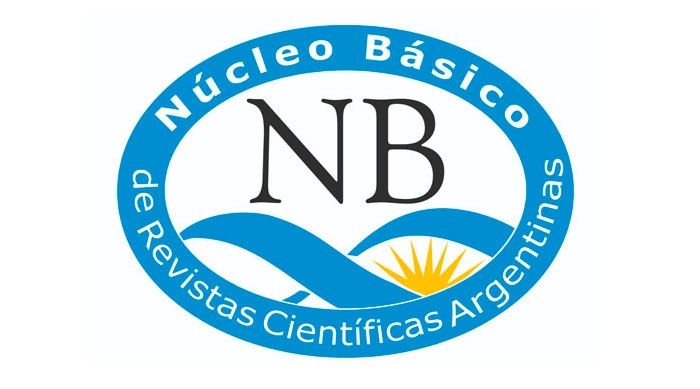Study of the acoustic emission of basaltic rock fracture in uniaxial compression test
Keywords:
basalt, Peteroa volcano, tensile crack, shear crack, acoustic emissionAbstract
Acoustic emission (AE) is a useful phenomenon to study structural materials under varying loading conditions. By linking mechanical behavior with certain AE parameters, information about nucleation processes and crack growth can be obtained. In the monitoring of volcanic structures, the study of elastic waves generated by rock fracture is of interest. In this work, uniaxial compression tests were carried out until rupture in basaltic rocks extracted from the Peteroa volcano in Argentina, and the generated AE was recorded with the aim of understanding the fracture mechanisms and obtaining indicator parameters that allow interpreting the dynamics of rock faults, often under compression. The load, controlled by displacement, was applied in stages of linear increase and others of constant load as a function of time. The amplitude, hits, counts, and accumulated energy were the most representative parameters to evaluate the damage progress in the rock. The predominant fracture mode during each loading stage was measured by a graphical method linking the FM and the RA value. It was calculated that in the initial stages, the predominant mode was tensile, while in the last stage, the number of signals from shear cracks was higher. The b-value was also calculated and found to decrease as the damage and AE energy increased. The results obtained allow a real-time characterization of the rock damage progress.
Downloads
References
Calabrese, L. & Proverbio, E. (2020). A review on the applications of acoustic emission technique in the study of stress corrosion cracking. Corrosion and Materials Degradation, 2(1), 1–30.
Cao, K., Xu, Y., Khan, N. M., Li, X., Cui, R., Hussain, S., & Alarifi, S. S. (2023). A comprehensive model for evaluating infrared radiation and acoustic emission characteristics of sandstone fracture. Engineering Fracture Mechanics, 283, 109217.
Carrasco, A., Méndez, F., Leaman, F., & Molina Vicuña, C. (2021). Short review of the use of acoustic emissions for detection and monitoring of cracks. Acoustics Australia, 49, 273–280.
Casals, B., Dahmen, K. A., Gou, B., Rooke, S., & Salje, E. K. (2021). The duration-energy-size enigma for acoustic emission. Scientific Reports, 11(1), 5590.
Colombo, I. S., Main, I. G., & Forde, M. C. (2003). Assessing damage of reinforced concrete beam using “b-value” analysis of acoustic emission signals. Journal of Materials in Civil Engineering, 15(3), 280–286.
Dong, L., Chen, Y., Sun, D., Zhang, Y., & Deng, S. (2023). Implications for identification of principal stress directions from acoustic emission characteristics of granite under biaxial compression experiments. Journal of Rock Mechanics and Geotechnical Engineering, 15(4), 852–863.
Filipussi, D. A. (2018). Caracterización de daño por “b-value” de eventos de emisión acústica en ensayos de rotura de roca andesita. Matéria (Rio de Janeiro), 23, e12068.
Li, S., Yang, D., Huang, Z., Gu, Q., & Zhao, K. (2022). Acoustic emission characteristics and failure mode analysis of rock failure under complex stress state. Theoretical and Applied Fracture Mechanics, 122, 103666.
Liu, X. L., Liu, Z., Li, X. B., & Han, M. S. (2019). Acoustic emission b-values of limestone under uniaxial compression and brazilian splitting loads. Rock and Soil Mechanics, 40(S1), 267–274.
Niu, Y., Hu, Y. J., & Wang, J. G. (2023). Cracking characteristics and damage assessment of filled rocks using acoustic emission technology. International Journal of Geomechanics, 23(4), 04023013.
Niu, Y., Zhou, X. P., & Berto, F. (2020). Evaluation of fracture mode classification in flawed red sandstone under uniaxial compression. Theoretical and Applied Fracture Mechanics, 107, 102528.
Ono, K. (2011). Acoustic emission in materials research-a review. Journal of Acoustic Emission, 29.
Rao, M. V. M. S. & Lakshmi, K. J. (2006). Amplitude distribution analysis of acoustic emissions and investigation of the development of brittle fracture in rock. Unpublished.
Rodrı́guez, P. & Celestino, T. B. (2019). Application of acoustic emission monitoring and signal analysis to the qualitative and quantitative characterization of the fracturing process in rocks. Engineering Fracture Mechanics, 210, 54–69.
Shi, X., Xu, H., Che, M., Xiao, C., Ni, H., & Gao, Q. (2023). Investigations of fracture behavior and pore structure change in pulse fracturing for cement block. International Journal of Rock Mechanics and Mining Sciences, 166, 105366.
Wang, Q., Chen, J., Guo, J., Luo, Y., Wang, H., & Liu, Q. (2019). Acoustic emission characteristics and energy mechanism in karst limestone failure under uniaxial and triaxial compression. Bulletin of Engineering Geology and the Environment, 78, 1427–1442.
Wieser, C., Käsling, H., Raith, M., Richter, R., Moser, D., Gemander, F., & Thuro, K. (2015). Acoustic emission technique to detect micro cracking during uniaxial compression of brittle rocks. Engineering Geology for Society and Territory-Volume 6: Applied Geology for Major Engineering Projects, 465–468. Springer International Publishing.
Wu, S., Qin, G., & Cao, J. (2022). Deformation, failure, and acoustic emission characteristics under different lithological confining pressures. Materials, 15(12), 4257.
Xie, Y., Hou, M. Z., & Li, C. (2023). Anisotropic characteristics of acoustic emission and the corresponding multifractal spectrum during progressive failure of shale under cyclic loading. International Journal of Rock Mechanics and Mining Sciences, 165, 105364.
Zhang, Z., Liu, X., Zhang, Y., Qin, X., & Khan, M. (2021). Comparative study on fracture characteristics of coal and rock samples based on acoustic emission technology. Theoretical and Applied Fracture Mechanics, 111, 102851.
Zhao, S., Chao, Q., Yang, L., Qin, K., & Zuo, J. (2022). A review on application of acoustic emission in coal—analysis based on citespace knowledge network. Processes, 10(11), 2397.
Downloads
Published
How to Cite
Issue
Section
License

This work is licensed under a Creative Commons Attribution-NonCommercial-ShareAlike 4.0 International License.
Starting in 2022 (Vol. 43 number 2) articles will be published in the journal under a Creative Commons Attribution-NonCommercial-ShareAlike 4.0 International license (CC BY-NC-SA 4.0)
According to these terms, the material can be shared (copied and redistributed in any medium or format) and adapted (remixed, transformed and created from the material another work), provided that a) the authorship and the original source of its publication (journal and URL of the work), b) is not used for commercial purposes and c) the same license terms are maintained.
Prior to this date the articles were published in the journal under a Creative Commons Attribution license (CC BY)
In both cases, the acceptance of the originals by the journal implies the non-exclusive assignment of the economic rights of the authors in favor of the editor, who allows reuse, after editing (postprint), under the license that corresponds according to the edition.
Such assignment means, on the one hand, that after its publication (postprint) in the GEOACTA Magazine of the Association of Geophysicists and Geodesists, the authors can publish their work in any language, medium and format (in such cases, it is requested that it be recorded that the material was originally published in this journal); on the other, the authorization of the authors for the work to be harvested by SEDICI, the institutional repository of the National University of La Plata, and to be disseminated in the databases that the editorial team considers appropriate to increase visibility. of the publication and its authors.
Likewise, the journal encourages the authors so that after their publication in the Journal of the Association of Geophysicists and Geodesists, they deposit their productions in other institutional and thematic repositories, under the principle that offering society scientific production and Unrestricted academic scholarship contributes to a greater exchange of global knowledge.
















